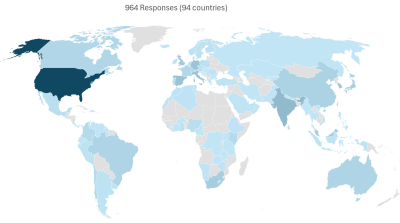Colombia, ranked as the fourth-largest economy in Latin America, is home to approximately 50 million people and boasts an impressive real GDP of US$754.65 billion. The nation's vast expanse of 37.5% agricultural land and abundant natural resources, including petroleum, natural gas, and coal, provides fertile ground for the widespread adoption of drone technology. With the potential to revolutionize various sectors, such as mining, the Colombian drone market is brimming with opportunities. These insights stem from the annual survey on the commercial drone industry conducted by Drone Industry Insights.
At the heart of Colombia's drone market lies a dynamic start-up ecosystem, with a plethora of companies, varying in size from 1-10 to 11-50 employees, spearheading the industry's growth. This vibrant and innovative landscape serves as a driving force behind the nation's drone industry. While many of these companies function as Drone Service Providers (DSPs), a substantial number focus on drone training and education, nurturing a pool of skilled professionals in the field. Additionally, nearly half of the drone companies in Colombia are actively engaged in a drone association, fostering collaboration and knowledge exchange within the industry.
Survey responses shed light on the top priorities of drone companies in Colombia, centering around marketing and sales, staff development, as well as financial and funding aspects. These priorities underscore the crucial need for companies to effectively promote their services, cultivate talent, and secure necessary resources to foster innovation and growth. However, the Colombian drone market faces several challenges, including issues related to public acceptance, geopolitical factors, and inflation. Notably, respondents expressed concerns over environmental opposition to oil and gas exploration, regulatory uncertainties, and the industry's readiness to embrace emerging technologies. To navigate these challenges, proactive regulation and robust industry support are deemed critical for propelling the drone market's growth and success in Colombia.
Despite the obstacles, drone companies in Colombia display a positive outlook for the coming year, rating their optimism at 7.1 out of 10, surpassing the global average of 6.6. Interestingly, the survey identifies the key market drivers for drones in Colombia, with rule-making authorities and DSPs exerting significant influence. Furthermore, respondents note a slight improvement in the regulatory landscape, indicating progress in creating an enabling environment for drone operations within the country.
In conclusion, Colombia's drone market stands on the cusp of remarkable growth and innovation, fueled by its dynamic start-up ecosystem. With the potential to revolutionize sectors such as search and rescue, agriculture, and mining, the drone market in Colombia offers a wealth of opportunities for companies to effectively promote their services, nurture talent, and secure the necessary resources to drive continuous growth and innovation. Despite challenges related to public acceptance and geopolitical complexities, the industry's unwavering optimism remains intact. By proactively addressing regulations and fostering strong industry collaboration, Colombia's drone market is poised to unlock its full potential, significantly contributing to the nation's economic growth and technological advancement.
















Comments